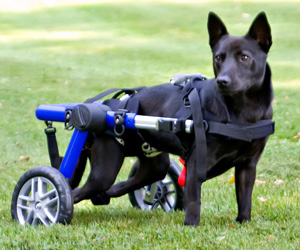Brands
How @HandicappedPets Harnesses Pet Lover Power
Mark Robinson introduced HandicappedPets.com to help pet owners avoid the tragic decision he made with his own dog many years ago. Due to his Keeshond’s disability, he followed the advice of a veterinarian and had her put to sleep. When Robinson launched the site designed to help owners of elderly, injured and handicapped pets in 2001, the groundswell of interest shocked him.

“I started HandicappedPets.com pre-social media with a message board, and to my amazement pet lovers came in droves,” says Robinson, who was motivated by the overwhelming response to invent Walkin’ Wheels in 2008. The patented wheelchair has sold thousands worldwide and was featured on the Animal Planet show “Underdog to Wonderdog” in January 2010.
While there are other sites in existence that carry pet wheelchairs or focus on animal rescue, none parallel the community found at HandicappedPets.com, which has 80,000 forum posts and more than 45,000 Facebook fans.
Contently recently talked with Robinson about how he leashes and holds the attention of pet lovers all over the globe.
Contently: How does your content strategy integrate with your company’s mission and vision?
Robinson: Our mission is to support the needs of people who wish to care for elderly, disabled or injured pets. Every page of the website is designed with this in mind. Before publishing, we always ask, “How will this help our community?” This method has been extremely helpful in building our extensive Facebook community. Only by staying completely relevant can we maintain this level of readership.
Contently: Is there an overriding theme that resonates throughout your content?
Robinson: Yes, I call it the “Awwwww Factor.” It’s the sound that readers make when they see a disabled dog walk with a wheelchair. Each page and post is geared to elicit an emotional response. The kind of content that does that are stories to which readers can empathize, support and assure them they’re not alone in their desire to help their handicapped pets, [as well as] technical information that gives them the tools to care for special needs animals.
Contently: How much and how often do you publish?
Robinson: Frequency and volume depend on the vehicle. We post to Facebook daily, blogs weekly and publish monthly newsletters. We add pages to the main website at a rate of approximately three pages every two weeks.
In addition to HandicappedPets.com, we own dozens of websites in the Handicapped Pets brand family, including DogKarts.Com, PetBoots.com, PetSafetyBelts.com, PetDiapers.com and Doggiewheelchair.com. Each of these pages is updated at least once a month. Typically, when a new product is introduced, we try to get a website with that product’s primary search term. This is the case with SplintsForDogs.com.
Contently: What types of content are the most well-received?
Robinson: Inspirational stories get the most hits. Like the boy in a wheelchair who adopted a dog, who also uses a wheelchair. Then there was the incredible story of the dog in Timor-Leste who was hanging from a butcher shop window with his back feet cut off. He escaped, was rescued and now has a happy life in a dog wheelchair.
Lucy is another dog who climbed Mt. Washington in a Walkin’ Wheels and appeared in a You Tube video. In many of these cases, we’ve donated the Walkin’ Wheels through the nonprofit Handicapped Pets Foundation, which also helps drive interest.
Contently: How do you determine the ROI on the content produced?
Robinson: Google Analytics and webmaster tools allow us to see exactly what is happening with the website and how people are traveling through it. We’re also experimenting with a toolbar that shows up on the top of the website that, based on several factors about visitors, helps direct them to the right place.
Whenever we add a new content piece to the site we watch the traffic it generates and the conversions created from it.
While the ROI of the business itself is measured in profits, the return on each piece of content is more centered around the “mission” and how it helps the community. If we provide service to the community of caretakers, we get necessary traffic to support operations. All we have to do is make the content relevant.
Get better at your job right now.
Read our monthly newsletter to master content marketing. It’s made for marketers, creators, and everyone in between.




